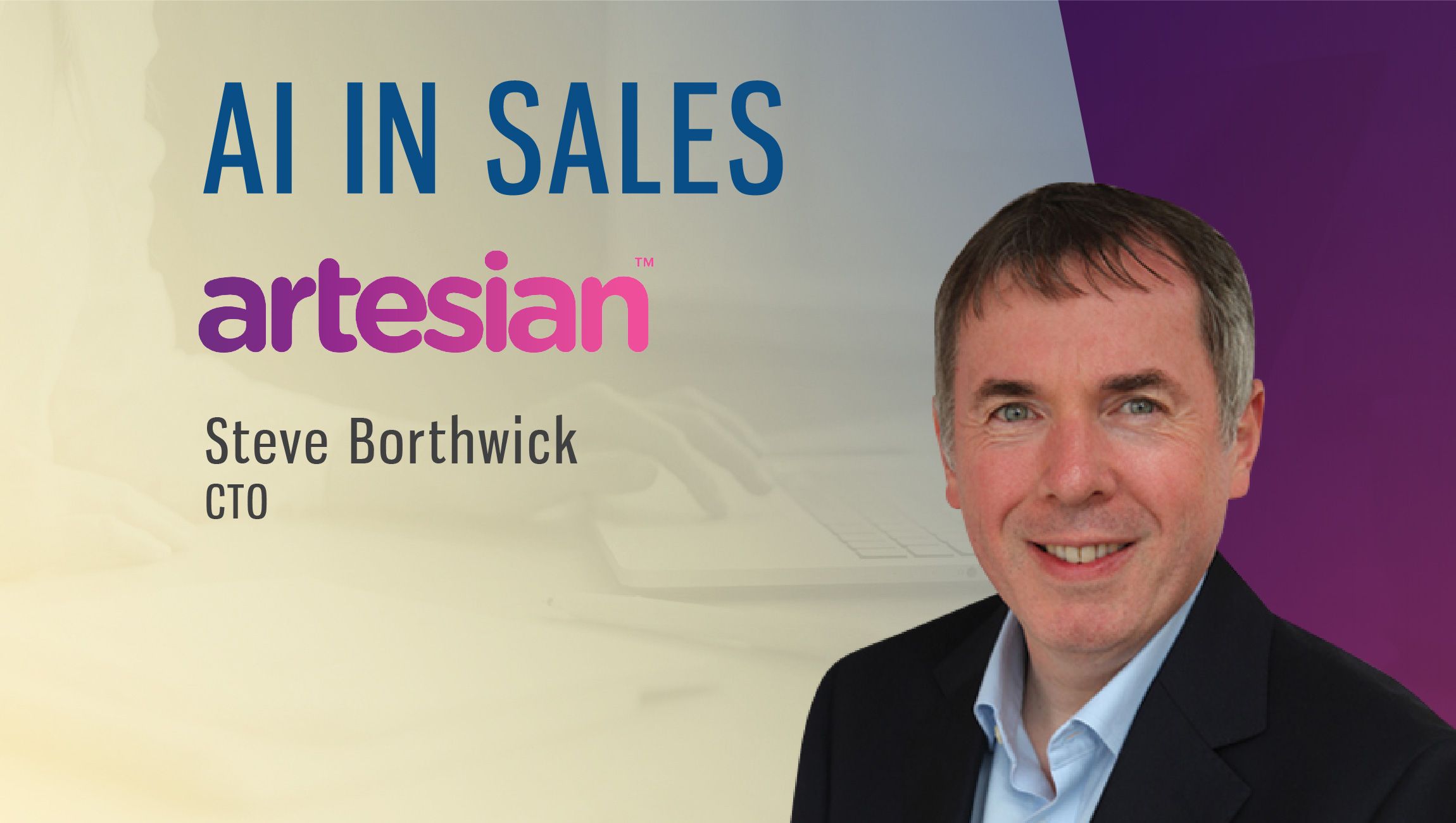Steve Borthwick
CTO, Artesian
It may seem that marketing and sales technologies are converging to deliver measurable ROI to CMOs. The major element driving this convergence is the prolific rate of penetration of AI/ML platforms. With global companies competing in the AI race, we tried to assess how the European market for sales automation and intelligence technologies compares against the Americas? To unravel these insights, and much more on AI for sales, we spoke to Steve Borthwick, CTO, Artesian.
Html code here! Replace this with any non empty text and that's it.
Tell us about your role at Artesian and the team/technology you handle
I am the CTO and co-founder of Artesian Solutions, a powerful AI-driven service that equips client facing teams with the resources they need to succeed in a modern commercial environment.
Artesian provides the data, real-time insight and context needed to find customers, create meaningful engagements, sell more and create long-lasting business relationships. With the use of AI technology layered on top of company information, data and news, Artesian continually scans millions of online resources and uses sophisticated algorithms, natural language processing, and machine learning to filter and transform that intelligence into commercially valuable insights that helps uncover opportunities, build relationships and accelerate deals, manage risk and create direct action.
As CTO, I have many responsibilities from driving forward our technical strategy and delivering continuous innovation in terms of our product architecture and design, to managing our engineering and quality assurance and support teams, as well as our technology partners.
Our small, agile team utilizes the latest advances in elastic search and distributed processing, machine learning, predictive and behavioral analytics and Natural Language Processing to cut through the white noise of big data and deliver commercially valuable and actionable intelligence to our users.
Our cloud-based SaaS solution, delivered via web-based and mobile applications is built on a micro-services architecture, an architectural style, a modular approach to software development for advanced development, deployment, scalability, and resilience of services.
What is the state of AI-driven Sales Intelligence technology in 2018?
In 2017, we saw many sales intelligence vendors jump on the AI bandwagon, repackaging their solutions so they could claim them to be AI-powered. In 2018, we will see a move away from this hype, and instead, we’ll see tangible developments fuelled by increased investment and experimentation.
We will see a wide range of AI’s and bots come to market designed to address clearly defined needs and problems, adapted and tuned to specific purposes. Artificial intelligence, machine learning, and predictive analytics will be put to use, enhancing current capabilities and tackling not just core but complex business problems.
For sales teams, an ever-greater spread of AI’s and bots within business systems will impact the traditional ways in which customers buy, as well as the ways products and services are sold and marketed.
At Artesian, we have many new projects in the pipeline all aimed at keeping us at the forefront of the sales intelligence market. In 2017, we launched ‘Insight Agent’, the first step in a series of intelligent chatbots aimed at automating many of the tasks carried out by B2B professionals daily, and Arti, our interactive digital assistant which enables intuitive interaction with our web content, in a human-like dialogue. We are constantly looking at the ‘what next’ scenario and pushing boundaries, and will soon launch new risk mitigation capabilities so watch this space.
How does the European market for sales automation and intelligence technologies compare with the Americas?
Looking at the obvious similarity to start with – on both sides of the Atlantic, people buy from people, and that requires deep understanding, empathy and trust. In the US, B2B buyers, and indeed consumers in general, are far more wary in terms of responding to outreach from sellers, which makes the job tougher. Add to this the fact that sellers in the US are typically starved of data, there is no equivalent to Companies House for example, and the result is that collecting commercially valuable intelligence and insight is harder and more expensive.
There is strong top-of-the-funnel focus, and contacts (LinkedIn connections) are more important in the US. Companies like DiscoverOrg, that provide engagement insights for the first point of contact, are doing well. But there is a significant gap in the market for solutions that augment these tools with ongoing insight – providing sellers with valuable intelligence at every stage of the sales funnel.
That is where Artesian can help. We have taken all that we have learned about the value of customer curiosity, insight-driven customer-centric engagement, and long-term relationship building in the UK and Europe, and have applied this to the needs of the US market. We provide US B2B sellers with more than just smart data and insights about customers but a complete sales engagement solution which complements services like LinkedIn and DiscoverOrg.
At Artesian, how do you verify the authenticity of data? How does that make your CRM and ABM integrations better?
Our users expect the highest levels of authenticity and credibility. Relevant and accurate data not only saves time and reduces false-positives, but builds trust and reinforces decision making. Data verification is an important factor in why we retain customers.
We only use reputable sources such as Experian, Dun & Bradstreet and Companies House etc. and we constantly cross check one source against the other. In addition, we have built a strong ETL (Extract-Transform-Load) layer that insulates the application.
By using Artesian to augment CRM and ABM solutions our users can:
- Deliver a complete 360° view of the business’s ecosystem
- Augment static data with real-time, contextualized customer insight
- Monitor and filter latest news sources, social media and corporate data based on a wide range of attributes, individual preferences and relevancy for accurate targeting
- Deliver a single view of all key stakeholders, with their social profiles, opinions, and expectations
- Deliver the functionality to respond immediately to live customer developments
- Monitor market trends and customer sentiment, then rationalize and plug this into open opportunities
As a result, our users gain an in-depth understanding of their pipeline, allowing them to uncover risks, act quickly on opportunities, anticipate needs and engage proactively in more sophisticated ways. They can segment and target audiences based on a real understanding of trends, sentiments, and needs, boost productivity and reduce the risk of inaccurate data by replacing manual input with automated insight and data.
How would you define Personalization- Segmentation- Optimization, and Automation at various stages of the Customer Lifecycle? How do you manage customer experiences at each level of this journey?
At the top of the funnel, segmentation is key to enabling extremely targeted connections and engagements. Broad segments, however, have very limited effectiveness and simply segmenting by demographics, geographic location, market, industry sector or even role is not granular enough to achieve the kind of highly personalized engagements customers expect today. Active segmentation must be the goal and this requires both qualitative (descriptive buyer-level insights, attributes and sentiments) and quantitative (firmographic) data points that help truly understand customers and what matters most in their world.
Looking at personalization and optimization. Tracking customers and prospects is a must to focus sales efforts in the right places and deliver truly personalized customer experiences, but perhaps even more importantly, in my opinion, is prediction. Mathematical modeling, predictive analytics, and machine learning enables sellers to find new patterns of event types, market challenges, and opportunities even in the most well-defined segments or within even the most well-known and understood customers. AI-powered strategies offer perhaps the best opportunity to derive true long-term customer lifecycle value by keeping sellers one step ahead, allowing them to continuously deliver highly personalized engagements and optimized outcomes.
Finally moving on to automation, many people still, unfortunately, hold the belief that in the ‘new world’ Artificial Intelligence will see much of the role of seller replaced by a bot and that delivering genuinely personal customer experiences will suffer as a result. In my experience, however, this is not the case. Far from taking away that all important ‘personal touch’, as B2B sales processes become more automated, I believe it actually serves to enhance personalization and optimize customer experiences.
Putting in place the tools that accelerate the process for key activities such as gathering information and insight to know the customer better, understand needs, predict trends and events, detect risks etc. means that decisions can be made faster and more accurately, leaving sellers free to undertake those strategic decision making and human touch relationship building tasks with an even greater level of clarity and more proactive and personalised customer experience approach.
How do you leverage AI/ML and data science at Artesian?
Artesian is making it possible to take advantage of pioneering Artificial Intelligence and machine learning technology, helping commercial teams uncover new opportunities and exploit endless possibilities through the power of data:
- Natural Interaction
Humans interacting with machines to achieve instant access to the highest-value information – golden insights that improve understanding of the customer or prospect and their drivers at any given moment, delivered in the efficient way possible for swift, empathetic and direct action.
- Prediction
Machine learning to construct predictive models based on patterns of event types and customer attributes that correlate more or less with eventual success – know next steps, better predict success and avoid failure – resulting in more sophisticated sales strategies, campaigns, and product or service development.
- Augmentation
Augmenting real-world activities with virtual sophistication. Navigating the big-data swamp by automatically locating the most relevant content and ranking and triaging it based on where a particular customer is in the sales cycle, as well as the people involved in decision making. Preparation for meetings, using real-time insight, past learnings from previous engagements, and take into account the fiscal, educational or motivational goals of the meeting itself.
- Active Segmentation
Augmenting static, cold data with real-time insights and real-world events, ensuring firmographic data is bang up to date and helping to uncover previously missed opportunities and new revenue streams. Using AI to gain an understanding of experiential factors from the news, views and opinions a customer or prospect has been generating to deliver a valuable 360-degree view of their ecosystem and therefore a much more targeted and accurate set of measures and triggers that can be used to perfect segmentation, lead generation and execution.
- Active Engagement
Utilising AI and MBL techniques to maintain a touch point with a customer or prospect and ensuring a level of attentiveness across an entire portfolio of people and businesses that would be very difficult to do manually.
How do you prepare for the post-GDPR era?
The key thing that will ultimately deliver success post-GDPR is data quality. Preparation for the post-GDPR era must, therefore, start with capturing and using data in a smarter way. GDPR reinforces the importance of how, where and why data is captured and used, as well as the cost of out-of-date data.
You could say that by solely relying on your own data held within your CRM solution, you can be more confident that you’re meeting the regulations. But in doing so you will limit the range of insight needed to deliver truly personalized strategies, at a time when customer intimacy is high on the agenda. A compounding issue is that CRM solutions are only ever as good as the data that’s entered into them. The data is static, rather than dynamic, and decays quickly raising a significant GDPR issue as the regulation stipulates personal data must be accurate and kept up to date.
There has been a lot of talk recently about LinkedIn, and more specifically LinkedIn Sales Navigator, as the best possible solution to prospecting and delivering personalized sales, marketing, and business development engagements post-GDPR. LinkedIn is a reputable source after all, and people join LinkedIn with the expectation that others will view their data and engage with them via messaging and InMail, therefore this kind of activity is essentially not impacted by GDPR. LinkedIn and Sales Navigator are fantastic tools, but isn’t reliance on one data source only marginally better than relying on your own internal data?
Therefore my top tips to prepare are:
- Get beyond the limitations of people data, self-declared data, and static CRM data by having a constant supply of relevant and validated insights from both structured and unstructured data sources across the internet, news and social media that will inform all sales, marketing and business development activities – greater personalization, improved engagement, demonstrating value
- Expand on the individuals curated view of the world and understand the wider internal and market influences affecting customer and prospects, as well as detailed corporate information – a 360° view
- Supplement Sales Navigator triggers (which can be infrequent), prospect with confidence, and demonstrate legitimate interest by having an up to date feed of insights such expansion news, management changes, legislative, regulatory, compliance and risk management changes and triggers, acquisitions etc.
- Make yourself an expert and interesting to your audience by using insights. Share content and publish thought leadership posts with a deeper, richer level of understanding
- Build value into engagement by having contextual reasons to reach out – readymade research, door openers and engagement topics. The result will be higher open rates, click-throughs, meetings and ultimately, revenue
- Augment connection requests with golden nuggets of insight, and contextual anecdotes
- Get beyond the virtual and integrate with your calendar to see the latest insights about customers and prospects you’re meeting with – marshal exactly the right facts at the right time (up-to-the-minute insights about everyone sitting around the table, their sentiments and expectations) to capture and hold the attention of the room
To conclude, GDPR reinforces the importance of using reputable third-party business intelligence sources that are not only compliant with the regulations but can also demonstrate consistent data capture across multiple channels and best practice in terms of data quality and validation.
A message for all business leaders preparing for the oncoming GDPR disruptions
If handled the right way, GDPR regulations will allow sellers, business development teams and marketers to strengthen their relationships with customers. You’ll have cleaner, richer data, and long-lasting relationships, with the result being more targeted messaging, higher and more valuable engagement, and most importantly, an advantage over less prepared competitors.
The best and most resourceful sales, marketing and business development teams are looking at the GDPR opportunity and seeing the bigger picture in terms of delving deeper into the needs of their prospects and customers.
Don’t just be compliant, tackle the data quality challenge by having access to richer data from a wide range of sources (both structured and unstructured) that will strengthen relationships, improve engagement and communications, and build trust.
Thanks for chatting with us, Steve.
Stay tuned for more insights on marketing technologies. To participate in our Tech Bytes program, email us at news@martechseries-67ee47.ingress-bonde.easywp.com











